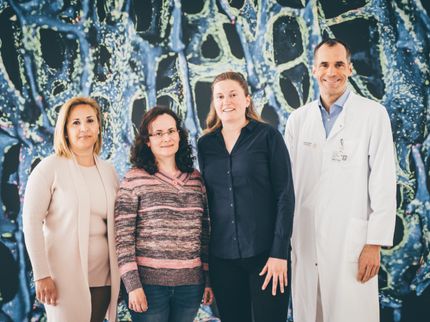Computer simulations help predict fracture risk
Using a Blue Gene supercomputer, scientists of ETH Zurich and the IBM Zurich Research Laboratory demonstrated the most extensive simulation yet of actual human bone structure. This achievement may lead to better clinical tools to improve the diagnosis and treatment of osteoporosis, a widespread disease that worldwide affects 1 in 3 women and 1 in 5 men over the age of 50.
With the goal of developing an accurate, powerful and fast method to automate the analysis of bone strength, scientists of the ETH Zurich Departments of Mechanical and Process Engineering and Computer Science teamed up with supercomputing experts at IBM's Zurich Research Laboratory. The breakthrough method developed by the team combines density measurements with a large-scale mechanical analysis of the innerbone microstructure.
Using large-scale, massively parallel simulations, the researchers were able to obtain a dynamic "heat map" of strain, which changes with the load applied to the bone. This map shows the clinician exactly where and under what load a bone is likely to fracture. "With that knowledge, a clinician can also detect osteoporotic damage more precisely and, by adjusting a surgical plate appropriately, can best determine the location of the damage," explains Dr. Costas Bekas of IBM's Computational Sciences team in Zurich. "This work is an excellent showcase of the dramatic potential that supercomputers can have for our everyday lives."
The joint team utilized the massively large-scale capabilities of the 8-rack Blue Gene /L supercomputer to conduct the first simulations on a 5 by 5 mm specimen of real bone. Within 20 minutes, the supercomputer simulation generated 90 Gigabytes of output data. "It is this combination of increased speed and size that will allow solving clinically relevant cases in acceptable time and unprecedented detail", says Professor Ralph Müller, Director of the ETH Zurich Institute for Biomechanics.
Going beyond static bone strength
Ten years ago, the world's most sophisticated supercomputer, called Deep Blue, would not have been able to handle the sheer size of the calculations. Even with sufficient system memory, it would have taken roughly a week of computing time - too long for meaningful impact on diagnosis and treatment.
"Ten years from now, today's supercomputers' performance will be available in desktop systems, making such simulations of bone strength a routine practice in computer tomography," predicts Dr. Alessandro Curioni, manager of the Computational Sciences group at IBM's Zurich Research Laboratory.
ETH Zurich Professor Peter Arbenz, who initiated the collaboration of the involved groups, explains that what was first needed was state of the art in numerical algorithms in order to solve extremely large problems in surprisingly short time, and that it is the first fundamental step towards clinical use of large scale bone simulations. "We are at the beginning of an exciting journey. This line of research must absolutely be continued in order to achieve our goal," he states. Scientists in future aim to advance simulation techniques to go beyond the calculation of static bone strength to the simulation of the actual formation of the fractures for individual patients, in yet another step towards the fast, reliable and early detection of people at high fracture risk.
Original publication: The work "Extreme Scalability Challenges in Analyses of Human Bone Structures" by ETH scientists Peter Arbenz, Cyril Flaig, Harry van Lenthe, Ralph Mueller, Andreas Wirth and ZRL researchers Costas Bekas and Alessandro Curioni was presented at the IACM/ECCOMAS 2008 conference in Venice, Italy, on July 2.
Topics
Organizations
Other news from the department science

Get the life science industry in your inbox
By submitting this form you agree that LUMITOS AG will send you the newsletter(s) selected above by email. Your data will not be passed on to third parties. Your data will be stored and processed in accordance with our data protection regulations. LUMITOS may contact you by email for the purpose of advertising or market and opinion surveys. You can revoke your consent at any time without giving reasons to LUMITOS AG, Ernst-Augustin-Str. 2, 12489 Berlin, Germany or by e-mail at revoke@lumitos.com with effect for the future. In addition, each email contains a link to unsubscribe from the corresponding newsletter.






















































